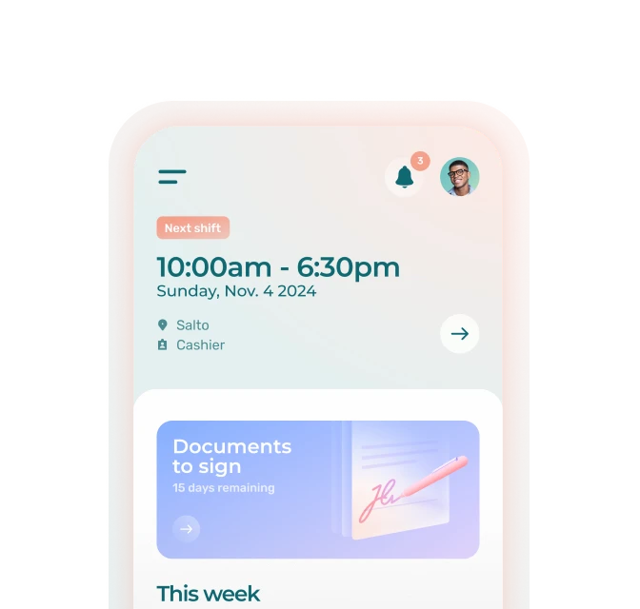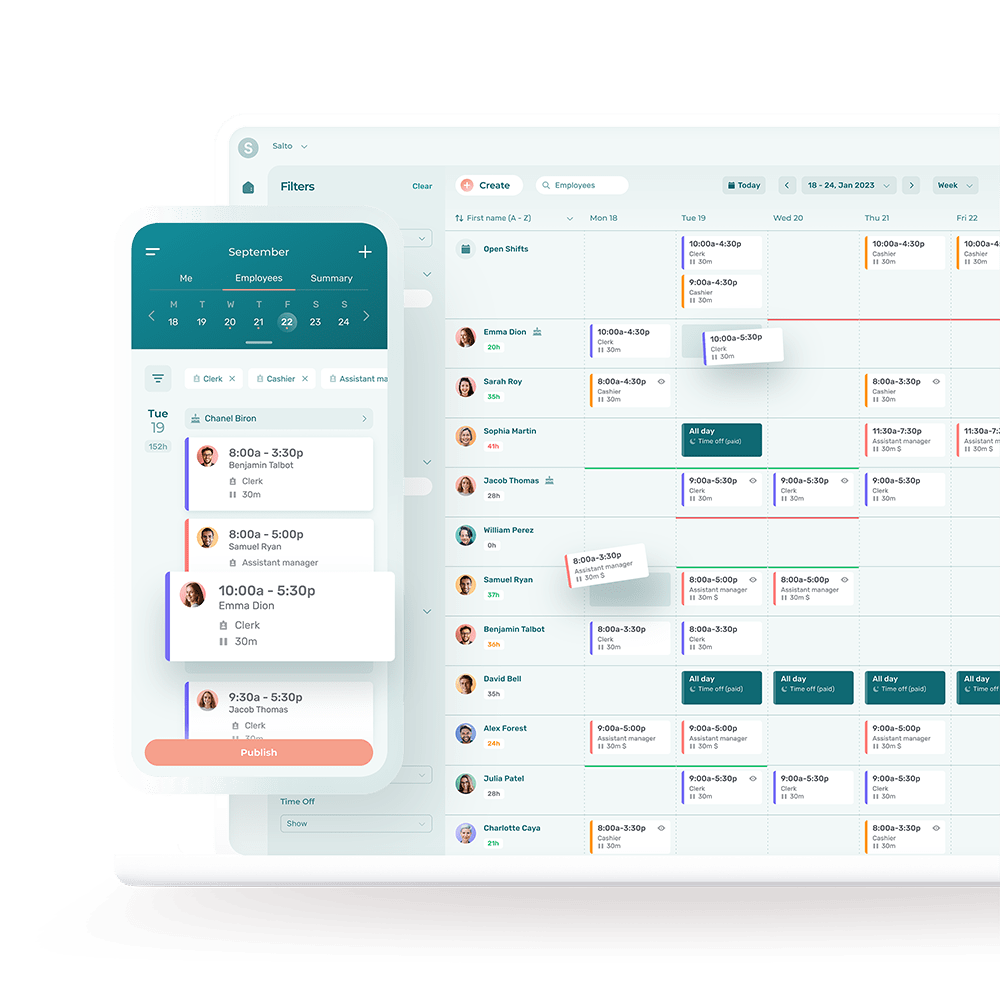Employee scheduling, when done right, can improve everything from employee retention to customer service. But when done wrong, it can lead to high employee turnover, dissatisfied customers and lost revenue.
Discover the best employee scheduling strategies for increasing job satisfaction, employee productivity and business performance.
In this article, we’ll cover:
- 12 employee strategies that work—at a glance
- The importance of employee scheduling
- 9 tips for scheduling employees effectively
- 12 employee scheduling strategies that work—in more detail
- Where to go from here?
- Scheduling strategy FAQS
12 Employee Scheduling Strategies That Work:
- Use an employee scheduling tool or a work shedule template
- Offer more flexible work schedules
- Hire more staff
- Hire part-time and seasonal workers
- Extend your business hours
- Plan work schedules well in advance
- Allow shift swapping
- Minimize employee turnover
- Create a clear policy for vacation and time-off requests
- Use employee availability forms
- Use employee overtime hours wisely
- Create back-up plans for sick, no-call & no-show employees
What Is the Importance of Employee Scheduling?
Employee scheduling is an important task in businesses of all sizes. It may be the small business owner who creates the employee workday schedule or the manager at a medium-sized business. Or the HR department in a large organization.
Regardless of business size or industry sector, all employee schedules need to ensure the right number of workers with the right skills are at the right work site at the right time.
A good schedule takes full advantage of the available human resources. It also ensures a smooth flow for important tasks, with quick completion time.
A great schedule does all this, while also improving job satisfaction and employee engagement. In turn, this improves customer service and business performance.
Benefits of Effective Employee Scheduling
When done right, employee scheduling can lead to:
- Lower labor costs.
- Better team member productivity and manager time management.
- Higher employee satisfaction and retention.
- Smoother business operations.
- Better business performance.
- Compliance with business requirements and labor laws.
Risks of Ineffective Employee Scheduling
- Poor employee morale.
- High employee turnover.
- Legal risks.
- Dissatisfied customers.
- Lost revenue.
- Lost business reputation.
Eliminate ALL Your Scheduling Headaches
Agendrix is an easy-to-use scheduling software that adheres to employee scheduling best practices. Create your next work schedule and share it with each team member in minutes. Book your free demo.
9 Tips for Scheduling Employees Effectively
- Simplify communication between managers and staff.
- Centralize employee records.
- Gather and document time off requests in advance.
- Use color coding.
- Track labor costs.
- Simplify employee scheduling for multiple job sites.
- Plan employee schedules around your busiest hours.
- Get feedback from staff.
- Create a scheduling template.
Dive deeper into these and other employee scheduling tips.
If you’re looking for a relatively simple scheduling method, you can also consider using a basic Excel file.
12 Employee Scheduling Strategies That Work
1. Use Employee Scheduling Software
There are several ways to create employee schedules, from work schedule templates to the old-school pen and paper method.
However, businesses that use an employee scheduling app like Agendrix report the biggest gains:
Employee software lets you:
- Centralize employee records.
- Automatically track time & attendance.
- Streamline employee onboarding.
- Conduct employee surveys.
- Facilitate exporting data for payroll.
According Softwareadvice.com, the top benefits reported by businesses that use scheduling software are:
- Entire scheduling process is quicker and easier.
- Ability to create an accurate and realistic schedule free of mistakes with minimal effort.
- Better visibility of work schedules for everyone (frontline workers, schedulers, managers, business owners).
- Better team productivity and collaboration.
For Employee Scheduling, and Beyond
Agendrix also includes automated timesheets, multiple ways to clock, an internal employee communication platform, employee surveying, onboarding and easy production of various reports.
2. Offer More Flexible Work Schedules
A flexible work schedule gives employees more autonomy to achieve a better work-life balance by giving them time to spend on the things that matter in their lives aside from work.
Why is this important? Offering a flexible work schedule makes it easier to recruit and retain better talent.
- 88% of workers want a better work-life balance.
- When looking for a new job, 86% of millennials say time off is a priority; 79% say flexible working is important.
What constitutes a “flexible” work schedule may vary depending on your industry.
- Construction companies that normally only schedule full-time weekday shifts could consider adding part-time weekend shifts to let workers clock more hours or take time off during the week to watch their kid’s school recital.
- Retail stores might consider adding seasonal shifts to cover the busy holiday period without overscheduling key staff. (See more retail scheduling strategies).
- A retirement home can consider switching from a fixed shift schedule to a rotating shift schedule so that the same employees don’t always have to work the same less-popular shifts.
- Offices & call centers can let employees set their own start and end hours for their shifts, or they can let them work remotely for all or a portion of the week.
3. Hire More Staff
Appropriate staffing levels help your company meet customer expectations and deliver great service. But properly estimating the right number of staff to schedule for each shift can be a delicate balancing act.
Risks of Being Understaffed
- Overworked and overscheduled employees.
- Increased possibility of burnout.
- Low employee morale and high turnover.
- Poor customer service, leading to lost business revenue and reputation.
Benefits of Hiring More Staff
- Easier to plan adapted work schedules that gives employees more freedom over their personal life, while ensuring all relevant tasks are covered.
- More sustainable workload for employees. Giving team members some mental space to recharge their energy levels will allow them to increase their productive time and do more impactful work. For example, this can mean giving an employee extra bandwidth to focus on key priorities or tackle fulfilling creative projects.
- Better employee morale and job satisfaction. You can move the needle forward on these key indicators by giving workers free days and long breaks to rest throughout the day (especially during the dreaded afternoon slump when natural energy cycles are at their lowest point).
- Improved employee engagement and customer service. Employees can focus intensively on different tasks and priorities related to customer satisfaction, without putting serious strain on any given team member.
- Lower costs due to overworked teams. It’s incredible what twenty five minutes of downtime can do for someone’s energy flow and productivity level.
4. Hire Part-Time and Seasonal Staff
Retail chains, restaurants & bars, hotels and other businesses with busy periods and seasons may choose to hire part-time and seasonal staff to cover peaks in customer traffic.
Benefits of hiring seasonal and part-time staff:
- Having a more flexible workforce makes it easier for managers to adjust the size of the scheduled team to the changes in workload.
- Hiring seasonal workers through a staffing firm can be a cost effective way to get the extra hands you need without the high costs. The staffing firm covers many of the hiring costs and employee benefits costs. It will also handle the time-consuming onboarding process.
- Protecting existing staff from becoming overworked and overwhelmed during peak business periods will improve team morale.
- Requiring staff to work less overtime will lower labor costs and minimize the risk of employee fatigue, employee burnout and employee turnover—all of which comes with financial costs and reputational risks.
Hiring seasonal employees and part-time workers will also give you extra people to call up if the flu suddenly lands half of your full-time staff sick in bed for the week.
5. Extend Your Business Hours
Some businesses have been forced to cut business hours recently due to the labor shortage. But not all businesses are lacking workers.
- Busy pharmacy stores and catering businesses might want to extend hours to meet increased customer demand.
- Many businesses, such as call centers, are looking to extend business hours to better serve global customers.
- Cleaning services and cities & municipalities may want to extend working hours to create efficient schedules options or employment opportunities for local workers.
6. Create Work Schedules Well in Advance
Creating and publishing work schedules in advance gives everyone plenty of time to consult them, flag any scheduling conflicts, request a swap shift and make the necessary scheduling changes.
In fact, labor laws in Canada and the US may require businesses to give employees a minimum advance notice of shift changes, additions or cancelations.
Some state and local scheduling laws even require businesses to pay a penalty to employees who are scheduled to work back-to-back shifts without enough off-duty hours in between the shifts (sometimes referred to as “right to rest” or “clopening” provisions).
7. Allow Shift Swapping
Shift swapping gives employees more control over work schedules and lets businesses fill empty shift slots.
While some employers worry that shift swapping will overly complicate employee scheduling, letting employees trade shifts can be incredibly beneficial for businesses with limited resources.
Allowing shift trading is a highly effective yet underrated scheduling technique that gives employees more opportunities to focus on their personal life. It also lets managers stay focused on more important and urgent tasks.
With employee scheduling software like Agendrix, managers can enter the criteria for what type of shift swapping is allowed, and set their level of involvement (need to post the shift swap request, need to approve the swapped shift, or just need to be kept in the loop if all the criteria for a traded shift are met in the scheduling software).
See how you can effortlessly schedule employee swap shifts in Agendrix.
8. Minimize Employee Turnover
Employee turnover can wreak havoc on employee scheduling. It’s also incredibly costly for businesses. Not just in terms of HR costs, but also in terms of the loss of potential revenue due to a drop in team productivity. Not to mention the toll it takes on team morale.
While some amount of employee turnover is to be expected in all industries, improving employee retention should be a priority for businesses of all sizes, regardless of their industry.
Businesses that improve the employee experience report better worker retention, employee engagement and customer satisfaction.
See how to measure your employee retention rate.
Benchmark your employee turnover rate against the industry average.
9. Create a Clear Policy for Vacation and Time-off Requests
As a manager, you know that granting time-off requests will lead to happier employees and a happier company culture. It will also help you retain top talent and keep your team motivated and engaged.
But you also have to balance employee and business needs. Having a time off request policy will clarify and streamline the process for requesting and approving vacation and time off requests.
A good time off request policy should include details like:
- How far in advance employees must submit time off requests.
- How often employees can request time off.
- Specific instances or times when time-off requests cannot be granted.
- How requests will be handled when multiple time-off requests overlap.
Having clear and fair HR policies will help you attract and retain quality talent.
10. Use Employee Availability Forms
Having employees regularly fill out an employee availability form lets managers and schedulers identify the shifts workers can and cannot work.
Employee availability forms are one of the most underrated scheduling techniques out there. Essentially, they are little more than a list of basic questions that managers can have employees periodically answer to verify their general work availability and shift preferences for the coming weeks and months.
These forms can vastly improve scheduling planning. They are an easy way to create more accurate schedules and save time when it comes to making scheduling changes and coordinating shift swaps.
They also show employees that you care about their work-life balance and work preferences.
An employee availability form should include:
- Employee contact information: name, phone number and/or email.
- Employee availability: days and hours when they are available to work.
- Employee non availability: days and hours when they won’t be available to work.
- A blank space for any special notes or unforeseen situations that may require future adjustments to the schedule.
- The date that they filled out the form, along with employee signature and the manager or shift supervisor’s signature.
11. Use Employee Overtime Hours Wisely
Overtime is not always a bad thing. In some instances, asking employees to work overtime can be the best choice for your business. In the short term, asking employees to work overtime:
- May be less costly than hiring and training a new employee.
- Lets you quickly fill in a sudden need for additional staffing while only having to pay for the time worked.
- Gives you an efficient way to ensure 24/7 coverage.
Overtime may be necessary now and then, but as a rule, it should be used in small measures and only as a short-term solution. Prolonged and excessive overtime can destroy employee morale and will be reflected in your profits.
12. Create Backup Plans for Sick, No-Call & No-Show Employees
All employers will have employees who call in sick from time to time—sometimes with little to no advance warning.
There’s little business owners can do about employee absenteeism due to illness. However, there are steps managers can take to reduce workplace absenteeism, especially when it involves no-call or no-show employees.
This begins with a good backup plan, prepared in advance. That way, if a key employee suddenly quits or is unable to work, the manager isn’t left scrambling to find a replacement. And the other front line staff working that shift aren’t burdened with a heavier workload.
See: 7 Steps to Developing a Replacement Plan
So Where to Start to Schedule Effectively From Here?
Like most other routine business processes, following industry best practices is a good first step. For 99% of businesses, that means using scheduling software. The benefits of using a scheduling software are many and often immediate.
A good employee scheduling software will allow you to organically implement whatever scheduling method or strategies you decide to use, making it easier to build a happier, more productive and successful team.
Quick deployment, minimal user training, round the clock support: Simplify employee management and scheduling with Agendrix software.
How to Ensure that Employee Schedules Are Fair and Equitable?
To ensure that work schedules are fair and equitable, you can:
- Make sure your job description clearly indicates the position’s work schedule and start date.
- Promote a communication culture, with the flow of communication going both ways.
- Talk to your employees and ask them to fill out an employee availability form.
- Define the rules for scheduling shifts to avoid scheduling issues like favoritism and overscheduling employees.
- Use an employee scheduling tool to automate the scheduling process while respecting your established scheduling rules.
- Communicate changes to your scheduling process to all staff and continue to optimize practices by encouraging feedback from employees.
- Support employees when needed by allowing them to swap shifts, either autonomously or through the manager.
- Have backup plan for vacation and sick days so that teams and managers aren’t left scrambling when an employee is absent.
- Forecast workloads and customer traffic to minimize overtime to control labor costs.
- Publish your schedule well in advance (at least an entire week ahead of time) so that employees have plenty of time to request changes or swap shifts if there’s a scheduling conflict.
- Track time & attendance to ensure employees respect their scheduled shifts.
How Can I Use Technology to Streamline and Automate the Scheduling Process?
Employee scheduling software can be a game-changer for any busy business owner who needs to make weekly employee schedules or who is looking to improve their time management. It automates workforce scheduling processes such as creating employee schedules, time tracking, and communicating with employees. It saves time, minimizes repetitive tasks, reduces errors and improves job satisfaction.
Agendrix software automatically alerts you in the event of a scheduling conflict. Discover to automate your employee scheduling process. Book your free demo!
How Can I Ensure Compliance With Labor Laws and Regulations Related to Scheduling?
To ensure compliance with labor laws and scheduling regulations, you can:
- Identify which federal and state/provincial labor laws apply to your business. Websites like the Department of Labor are a good place to start.
- Create a labor compliance checklist of all the laws you need to respect. Add any recurring or urgent tasks to your calendar to ensure they are done in a timely manner and that nothing slips between the cracks.
- Create an employee handbook. It will give your staff important information about their rights and benefits. It will also help to reduce misunderstandings that can sometimes lead to employee lawsuits.
- Do a job discrimination self-audit. It will tell you what discriminatory practices may be opening your organization to potentially damaging employee grievances.
- Use an employment agreement. It will help you protect the rights of your staff and of your business.
How to Make an Efficient Work Schedule?
To prepare effective work schedules, managers must:
- Use high-performance technological tools such as scheduling software
- Analyze their workforce needs in terms of tasks and workload
- Plan work schedules at least 2 weeks in advance and communicate them to team members giving 1 week’s notice or as required by law
- Be flexible and allow employees to swap shifts as needed
- Build high-performance work teams
- Follow up on employee time-off requests on a regular basis
- Respect employee availability
What Is an Efficient Schedule?
An efficient schedule makes it possible to offer exceptional customer service while respecting employee availability.
An efficient schedule typically includes:
- A workforce sized for the flow of traffic
- Effective solutions in case an employee or several employees are absent
- Break times for all employees
- Respect of team members’ availability
- Enough time to open and close the store or restaurant, if applicable
- No overtime
How to Plan Work Schedules?
To plan work schedules, managers or business owners must:
- Track employee time and attendance
- Calculate the number of overtime hours
- Determine necessary staff rest time
- Determine the company’s workforce requirements
- Consider employee time off requests
- Create work schedules and share them with employees
- Modify schedules as needed based on feedback from staff
- Ensure compliance with applicable labor laws
What Does Effective Employee Scheduling Look Like?
A good work schedule generally includes:
- Little or no overtime
- Enough rest periods for employees
- Enough staff for busy periods
- Compliance with labor standards











